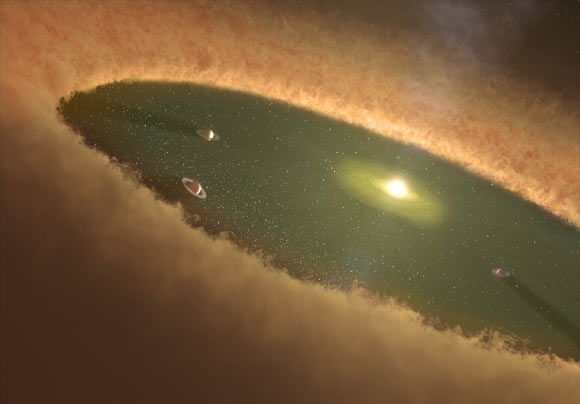In a paper published online today in Nature, an international team of scientists explains how the cores of gas giants formed through the accumulation of small, centimeter- to meter-sized, ‘planetary pebbles.’

This artist’s concept of a young solar system shows gas giants forming first, while the gas nebula is present. Prof Martin Duncan and co-authors used computer simulations to nail down how Jupiter and Saturn evolved in our own Solar System. These calculations show that the cores of gas giants likely formed by gradually accumulating a population of ‘planetary pebbles’ – icy objects about a foot in diameter. Image credit: NASA / JPL-Caltech.
Giant gas planets in the Solar System likely formed first. Jupiter and Saturn presumably accumulated their gasses before the Solar Nebula dispersed.
Observations of young solar systems show that the gas disks that form planets usually have lifetimes of 1 – 10 million years, which means the gas giant planets in the Solar System probably formed within this time frame.
In contrast, the Earth probably took at least 30 million years to form, and may have taken as long as 100 million years. So how could Jupiter and Saturn have formed so quickly?
The standard model of planet formation states that the cores of gas giants formed through collisions between much larger bodies 100-1,000 km in size, known as planetesimals.
However, this model would not have allowed the cores to form quickly enough to capture the gases that make up their atmosphere in the early Solar System.
The new model, created by Prof Martin Duncan of Queen’s University in Kingston, Ontario, and his colleagues from Southwest Research Institute, shows that collisions and accumulation of the so-called pebbles would have allowed the cores to form much more rapidly.
“As far as we know, this is the first model to reproduce the structure of the outer Solar System – two gas giants, two ice giants (Uranus and Neptune), and a pristine Kuiper belt beyond Neptune,”said Dr Duncan, senior author of the Nature paper.
In addition, the new model accurately predicts the formation of one to four gas giant planets; consistent with what we see in the outer Solar System.
“It is a relief, after many years of performing computer simulations of the standard model without success, to find a new model which is so successful,” Dr Duncan concluded.
_____
Harold F. Levison et al. 2015. Growing the gas-giant planets by the gradual accumulation of pebbles. Nature 524, 322–324; doi: 10.1038/nature14675







